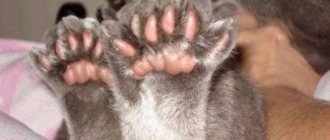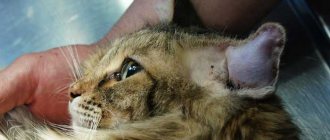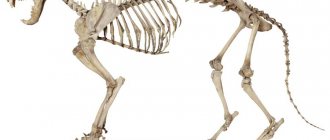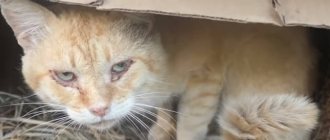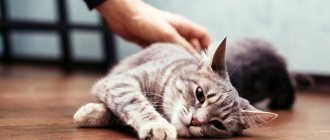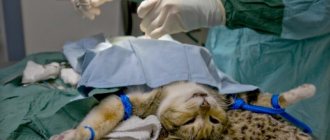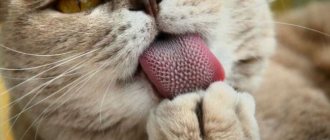6759Pavel
Do cats have nipples? This question arises from owners probably least often. The answer to this question is obvious to many. Such questions most often arise in cases where a cat has any kind of compaction or inflammation. Yes, cats have nipples. In fact, they do not perform any functions, since cats do not need to feed kittens.
In this article we will talk about misconceptions related to mammary glands in cats, as well as what condition is acceptable.
How are a cat's nipples located?
Both male and female cats have nipples. Normally there are four breast nipples located almost symmetrically, two abdominal and two in the groin area. Blood and lymphatic vessels are located vertically in the mammary glands - from the groin to the armpits.
© shutterstock
Sometimes pet owners say that a cat has 6 nipples, and they are located asymmetrically, sometimes even in a checkerboard pattern. There are also odd numbers of nipples. There is one unpaired nipple near the armpit, in the groin. Or one pair is missing one nipple. This situation occurs during intrauterine development and during puberty; one or two nipples simply have not fully formed. And this does not in any way affect the health of the ward.
Causes of nipple anomalies
Anomalies in the shape, location and number of nipples are congenital and are caused by a violation of the formation of these organs in the prenatal period. As a rule, such disorders are caused by pathogenic effects on the body of a pregnant cat. But the formation of glands can be affected by hereditary factors - chromosome failure or gene diseases.
Injuries and infections of the mammary glands in kittens can cause disruption of their development. Endocrine diseases also cause underdevelopment of the nipples. If the anomaly does not interfere with the animal’s life and does not affect its health, then the anomalies are safe.
Are there problems with the functioning of nipples in cats?
The main thing is not the number of nipples a cat has, but their functionality. Sometimes, a cat, even with a “normal” number of nipples, does not have enough milk when feeding kittens. And this happens quite often - the nipples do not fulfill their purpose, there is no lactation. This happens because some pathological failure occurred at the time of development.
Sometimes, on the contrary, a cat has only 5 or 6 papillae, but produces enough milk for offspring.
Problems arise when a multiple pregnancy occurs. And the number of kittens born exceeds the number of nipples in which milk is produced. Therefore, some kittens may be malnourished.
This situation can be completely resolved by carefully monitoring the babies and, if the need arises, some kittens can be fed artificially. Then all the babies will survive and be healthy and prosperous.
© shutterstock
Anomalies and pathologies
The most common anomalies and pathologies are mastitis and mastopathy. Inflammation can appear not only in individuals who have given birth. The disease affects young cats, and sometimes male cats.
Surgical treatment of cats is indicated for abnormalities
The causes of the anomaly are hormonal imbalance, trauma, bruise. In addition to swelling, cats feel pain, and as the condition develops, purulent discharge appears. Severe cases require surgery.
Mastopathy is manifested by thickening of the tissue adjacent to the nipples. Progesterone is the cause of the abnormality. In addition to the nipples, the animal's paws become swollen. Treatment occurs with antibiotics, but advanced cases require special chemotherapy.
Important! The only preventive measure for mastopathy is considered to be sterilization of cats at a young age, when sexual heat has not yet arrived.
The health of newborn kittens depends on the condition of the cat's nipples. If they are restless, gain little weight, sleep poorly and squeak, it means there is not enough milk. The reasons are as follows:
- low maternal milk production;
- maternal stress;
- diseases and pathologies in cats.
Another anomaly is various tumors, which, like in humans, can be benign or malignant. The development of anomalies is usually slow, they degenerate from one form to another. Rapid progress is observed only with malignancy, but in this case the enlargement of the nipples is visible. The sooner help is provided in this condition, the more successful the outcome can be expected.
Mammary glands are found in both males and females. The normal arrangement is in pairs, but there are deviations from the norm. A different location of the nipples usually does not have a negative impact on the health of the individual. The condition of the skin and the size of the mammary gland must be monitored. This will help avoid a serious incurable disease, and possibly the early death of your beloved pet.
In the article I will consider the question of how many nipples or tits a cat has and the options for their location. The main reason for the presence of papillae in a cat. I will describe the structural features of the mammary glands and their possible diseases.
Does the number of nipples a cat has depend on the breed?
No such dependence is observed. Cats have lived next to humans for several thousand years. During this time, many breeds of domestic cats were developed. To live in an apartment, owners usually choose medium-sized breeds, smooth-haired or fluffy. All cat breeds should have 8 nipples as a standard. No special breeds have been bred in which the number of nipples is different.
Cats of small breeds have correspondingly small mammary glands. Large breeds also have large nipples.
How to determine if a cat is pregnant at home: first signs in the early stages
The most successful period for mating is 3-5 days from the start of estrus.
For the process to be successful, the cat must temporarily move in with the cat, and in the first few hours the animals may have misunderstandings and even fights. It is better to give the female time to calm down and get used to the new environment. It is best for the move to take place on the first day of estrus. Moreover, the cat itself begins to flirt with the cat, provoking him to take active actions, then shows aggression, not letting him near her. Sometimes a cat covers a cat, several times, but the long-awaited success is not observed. In order to figure out whether full coverage has occurred or not, you need to know the signs of successful mating:
- After contact with the cat, the female begins to roll around on the floor.
- The mucous membranes of the genital organs swell and become brighter in color.
- The male completely loses interest in the cat, calmly moves away, and begins to lick himself with enthusiasm.
- If, nevertheless, the cat continues to pay attention to the female, he receives a sharp refusal.
- The cat may lose its appetite and become lethargic within 4 days.
If your cat has a fever and bleeding from the genitals, you should consult a veterinarian.
Not every mating can result in pregnancy. In the early stages, it is quite difficult to find out whether a cat has managed to get pregnant, but you can try to figure it out based on the following signs:
- If after mating the female continues into estrus, then most likely the long-awaited process has not occurred.
- After pregnancy, a cat can be affectionate.
- The animal develops drowsiness, apathy, and decreased appetite. The previously active mischievous woman has turned into a lazy creature - this is how hormonal changes affect her.
- A sharp change in the behavior of the female may indicate hormonal changes in the body.
- In the early stages, a change in the color of the nipples occurs, which turn pinkish. There are times when changes in color do not occur in all nipples, but only in some.
More precisely, it is possible to say whether conception has occurred in about three weeks. The following symptoms will help you understand:
- You can use palpation to determine the presence of embryos in the tummy. Pressure must be done very carefully so as not to harm the babies. Too harsh an examination can cause a miscarriage.
- The mammary glands and nipples become swollen and acquire a brighter color.
- There is a sharp increase in appetite, and variability in the perception of foods may occur. Previously consumed food may be rejected, and interest in previously unloved food may appear.
- At 3-5 weeks, the tummy becomes rounded.
- When they reach 6 weeks, the kittens can be palpated.
- At 7-8 weeks, it is possible to notice the movement of the babies, feel the heartbeat, and identify the head and body.
We suggest you read: Proper maintenance and care of the African hedgehog at home
It also happens that you can’t get to the doctor, but you really want to find out about the likelihood of an “interesting situation”. Take a closer look at the cat’s behavior - it can “give itself away”:
- The first sign you may notice is the cessation of estrus. If the pet that was asking to go outside resolutely refuses to go out, stops making uterine sounds and loses all interest in males, expect a new addition to the cat family. However, it may not exist - everything is individual.
- Another sign that is hard to miss is drowsiness. Priorities are changing - now the first place is taken by proper rest. Your pet no longer runs after a ball or toy mouse. She has more important things to do - she saves the strength to bear the fetus.
Veterinary practice of specialists from all over the world clearly proves that in almost 100% of cases cats give birth perfectly on their own, without any need for outside help. Despite this, a pet with a bloated belly and enlarged nipples (that is, there are literally a few hours left before giving birth) needs special attention and care.
Prepare for the imminent appearance of kittens and when other signs appear:
- The cat begins to fuss and run around the house looking for a suitable place. As a rule, such a picture is observed a couple of days before a significant event, but still a lot depends on the animal itself. Some cats behave this way throughout pregnancy.
- The body temperature of cats approximately 12 hours before birth drops to 37.5-37.8° Celsius.
- In addition, immediately before the birth of kittens, the animal often becomes especially “talkative” and constantly meows, and also seeks the company of its owner. This behavior is not typical for all cats.
- About five days before giving birth, your pet may become dirty. You may notice that there are always some reddish-pink “pieces” at the root of the animal’s tail. The appearance of such signs indicates the beginning of the cervical mucus plug, which indicates a very early onset of labor.
- The immediate beginning of the labor process is “hinted” by strong contractions of the abdominal muscles. True, the initial contractions can last up to a day, so in any case you will have to be patient. Finally, the kittens are about to begin to appear when a watery discharge of a yellowish-red hue with a specific odor (amniotic fluid) appears from the external genitalia.
Once again, in most cases, cats give birth without any problems, and therefore they will not need your help (or, preferably, the help of a veterinarian).
We suggest you read: Review of flea remedies for rabbits
If the cat is constantly straining, but within 15-20 minutes from the moment the water breaks the baby still does not come out, be sure to call a doctor. The same applies to cases of “dry” pushing, when the cat pushes to no avail for an hour or more. If you delay in such situations, there is a high chance of losing the mother herself and all her offspring.
Mammary gland diseases in cats
The most common mammary gland diseases in cats are::
- Mastitis
- Mastopathy
- Breast tumors
Treatment of these diseases can be either medicinal or surgical. The glands affected by the tumor must be removed so that the disease does not spread further.
Mastitis
Mastitis sometimes appears immediately after the birth of kittens, with excessive milk production during the feeding period of kittens, and it can also be caused by a false pregnancy.
This is inflammation of the mammary glands. At the same time, the mammary glands enlarge, redness of the skin in the area of the nipple is observed, the temperature of the skin itself and the whole body rises. Soreness occurs. If the owner tries to touch the belly, the cat resists and does not allow him to touch her. With the milk, a foreign liquid comes out of the inflamed mammary gland - it is yellowish in color, and there may be an admixture of pus and blood.
Kittens should never be fed this kind of milk, as this can lead to their death. Mastitis is quite easily curable, but sometimes it can recur the next time after childbirth.
Mastopathy in cats
Mastopathy is an enlargement of the mammary glands. It can be completely normal, or it can turn out to be a pathology. Ordinary, physiological mastopathy occurs at the time of false pregnancy, feeding kittens. This process occurs naturally and does not have any negative consequences.
© shutterstock
Pathological mastopathy occurs as a result of hormonal imbalance. In this case, the mammary glands become dense, and a grayish liquid appears in them. The skin around the nipples takes on a bluish tint. These are soft or quite elastic, if you touch them carefully, seals. Often this condition may be precancerous.
The anatomy and structure of the glands is normal
The anatomically correct shape of a cat's mammary glands is cone-shaped. The height of the cone is about 1-3 mm; there are no hairs in this part of the body. It can be difficult to find glands in individuals with thick fur, especially in young ones. It's also hard to know whether furry male cats have nipples. This part of the body becomes clearly visible during pregnancy of cats of any breed, then it is obvious how many breasts the cat has. Particular growth and swelling is observed from the third week from the moment the embryos appear.
Mammary glands are needed for feeding offspring
Feeding helps open the milk tubules, so nutritious milk flows through them. Usually there are from 4 to 8 channels. The liquid outlet after feeding is closed with special valves, so the nutritional mixture does not leak out. The number of offspring depends on the number of milk ducts. This factor is regulated by nature. Giving birth to more kittens leads to the death of the offspring.
Important! A larger amount of milk is located at the inguinal glands, so strong kittens try to latch onto this part.
Normal location and quantity
In veterinary medicine, it is considered normal for a cat to have 8 paired nipples on the lower part of its body. They are placed in the following pairs:
- 1 pair in the thoracic region (can be felt near the front paws);
- 2 pairs in the abdominal region (can be located at equal or uneven intervals);
- 1 pair in the inguinal region (placed in the depressions near the hind limbs).
An interesting fact is that innervation and nutrition in them is carried out not in pairs, but in vertical rows (on one side of the body, lymphatic drainage, blood vessels and nerves sequentially connect the right nipples, and on the other side - the left ones). That is why pathologies and dysfunctions most often spread on one side.



